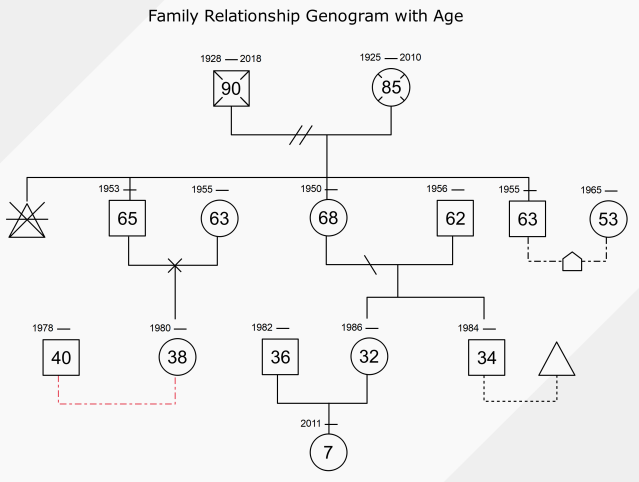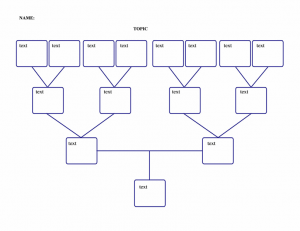
Genograms: The new tool for exploring the personality, career, and love patterns you inherit. Genograms: Assessment and intervention (3rd ed.). The following books have been genogram "Bibles" for me throughout the years: It will also help you to have sample genograms as you move forward with tracking patterns over generations.
Genogram example 3 generations manual#
In order to continue your family of origin exploration, you will need a manual for learning about genograms and genogram symbols. Also complete the family of origin system for your partner. Her older brother is married, and he is connected to his wife, as well as his family of origin.Īs you draw this generation, make sure to include all siblings, and their relationships and children. She has been linked to her FOO by a solid line placing her in her sibling position as the second child of two children. In the figure below, Amy's genogram has been extended to include her family of origin, including her older brother, her mother, and her father. 2 | Add the next generation, and place yourself and the members of your generation in the corresponding relationships and sibling positions

I am not suggesting you take this on right now, but I am encouraging you to not set a limit for yourself, because you never know what you might learn during your exploration. My genogram included my great-great grandparents. For my first genogram, I included five generations I was a member of the first generation at the time, because I did not yet have a child. Your basic genogram will include at least three generations "above" your generation, but ideally, you'd include as many generations as possible. This will make it easier to add generations as you continue. In the example below (Figure 1), Amy is the therapist creating the genogram she is the "explorer." She is married to Bob, and they have a daughter, "M." Marriage is noted by the solid line that connects Amy to Bob, and runs above "M." If Amy and Bob were not married, this line would be dashed (as shown in Figure 2).īegin drawing your genogram low and centered on the paper. When you draw your symbol, include a double line (circle or square) to signify that you are the one taking on the family of origin exploration. If you create a genogram with a client, then the client is the "explorer." It includes: your parents, if you live at home your partner, if you live with him/her your children, if you are a parent. Your current family system is you, in your current relationship or living situation. 1 | Draw a basic genogram, beginning with your current family system I created the genogram that I use for illustration in this post using Microsoft Word, by inserting shapes. You can create also create a genogram electronically using GenoPro or Microsoft Word. If you're comfortable hand-drawing your genogram, then you'll only need the first three items. Suppliesīefore you begin, gather the following supplies: But, right now, you will focus on four foundational steps. During future steps, you will expand on the details of your genogram and include dates, relationship dynamics, and patterns.

Creating Your Genogramĭuring this step, you will be creating the basic outline of your three to four generation genogram and noting all family members, relationships, and deaths. The genogram was developed by Murray Bowen, but has since been adopted by many family therapy approaches, as well as disciplines outside of family therapy.

Its purpose is to help the member of the system (in this case, you) see their context in visual form, so that pivotal moments and notable patterns can be acknowledged and recorded (Kerr & Bowen, 1988). What is a genogram?Ī genogram is a visual representation of a family system, incorporating at least three generations of the system.
Genogram example 3 generations how to#
I explain how to create a basic genogram that you can expand as you continue your exploration. In today’s post, I offer the next step in developing understanding: Creating your genogram. Bowen (1985) believed that if clients could understand themselves as members of their FOOs and as created by their histories, they could begin and continue significant change. Understanding is the foundation of Bowen Family Systems Theory (BFST). Hopefully, your curiosity has led to significant understanding. In article three of the Family of Origin for the Therapist series, you learned 3 simple steps for how to begin family of origin (FOO) exploration: 1) read Bowen’s chapter, 2) observe your FOO experience, and 3) reflect on what you learned.


 0 kommentar(er)
0 kommentar(er)
